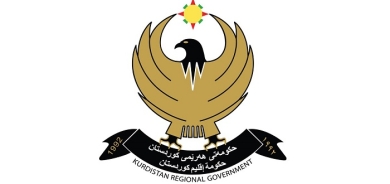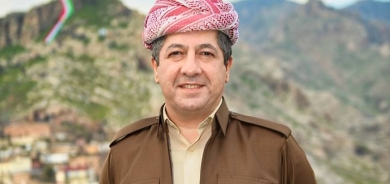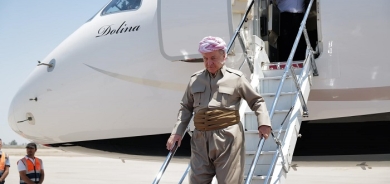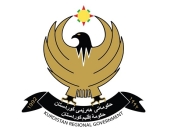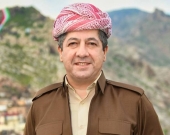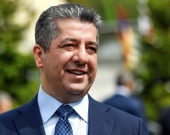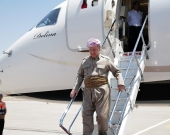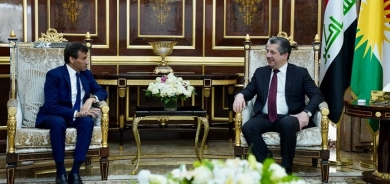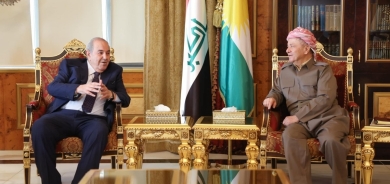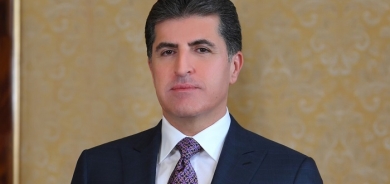Combatting Terrorism with Geospatial Technology
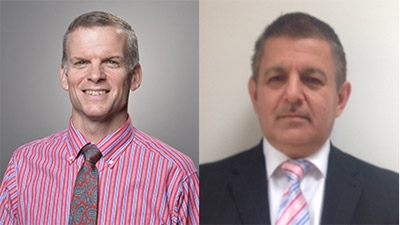
Royal School of Military Survey
UK
2. Dr. Joseph Henderson
Georgia Gwinnett College
USA
The authors explore the basis for how the combined western air attacks and Kurdish ground forces attacks against ISIS could be made more effective by having Kurdish forces acquire the use of
GIS and web technologies as part of their geo intelligence gathering capabilities.
ISIS is a terrorist organisation unlike many of its predecessors as it is territoriality grounded and connected to land-ownership. Because ISIS is attempting to set up a legitimate governing authority in the lands that it occupies, it is more of an insurgency than a terrorist group. The geographic extent of the caliphate that it intends to establish lies well beyond the current territories that it holds in Syria and Iraq. ISIS’s key strengths lie not in military hardware but in years of planning and foresight and a sophisticated tactical and strategic command. The group has a well-organized psychological operations campaign and a substantial financial portfolio. ISIS has managed to garner support through its propaganda and adroit appeals to certain disenfranchised and marginalized ethnic groups such as the Sunni Arabs in Iraq.
The way to defeat it requires us to understand not in a narrow and localised perspective such as its military capabilities or its numerical potential. There is an absolute need for a richer understanding of ISIS from a much broader scale which takes into account its roots, environment, historical background, finances, etc.
This article sets out in broad terms a blue print for how the “bigger picture” understanding of ISIS can be developed and shared by all forces combating the organisation, especially friendly ground forces such as the Peshmerga who are currently engaging ISIS. Here we propose the use of Geographic Information Systems (GIS) and its various Geo Intelligence technologies as a potential platform.
A report published in 2014 by The Institute for the Study of War (1) states that it is particularly important to move beyond narratives of simple or piecemeal solutions. Individual actions are insufficient to dislodge what has become an entrenched strategic adversary.
The strategy to defeat and destroy ISIS must instead be determined, deliberate, and phased, allowing for iterative decisions that adjust the plan in response to the actual realities on the ground.
The report goes on to point out western powers are not currently in a position to gauge these ground conditions accurately, and they need a more direct engagement with friendly forces on the ground to develop an accurate intelligence picture.
The impact of western airpower led by US and UK air forces targeting terrorist camps and convoys of ISIS is having the desired effect of containing and slowing down the group’s advances into Kurdistan and the other parts of Iraq. It is, however, a recognised fact that defeating this organisation and its army requires what is known as boots on the ground. At present, Kurdish Peshmerga forces are leading ground attacks against ISIS. However, for this force to provide a more focused and useful contribution to the western air campaign, it must make a marked shift in its use of modern computing technology as a way of gathering, processing, and disseminating geo intelligence data about the terrain, ISIS personnel locations, and their movements to western military aircrafts. To help defeat an adaptable enemy, teams on the ground will need to increasingly focus on conducting geostatistical analysis to anticipate enemy actions from past events. Time, location, and other factors are related statistically to identify actionable patterns.
A GIS is a computerized database management system for the capture, storage, retrieval, manipulation, analysis and display of spatial (i.e., locationally defined) data.
We will demonstrate how temporal/spatial analysis and predictive capabilities of this technology can turn the very strength elements of ISIS and its spatial expansion against it and help better inform military planners to formulate a decisive strategy to defeat it.
The military threat ISIS poses hinges on a number of defining factors. ISIS is a:
• fast moving mobile military force, often made of small/ medium size units.
• armed with heavy weapons.
• attacks civilian and military targets.
• multinational army crossing regional state boundaries.
• large army, in terms of numbers, in its totality (exceeds 30,000 fighters).
However, this is only a partial view of what is needed to fully understand and thus counter the threat of ISIS.
A report written by Richard Barrett and published in 2014 by The Soufan Group(2) outlines a taxonomic view of the main operational pillars upon which ISIS builds and derives its strength and existence. The report identifies four main types of operations: 1) Military, 2) Administrative, 3) Financial, and 4) Media.
An understanding of each operation should help inform the development and use of the GIS technology mentioned earlier. In this article we will focus attention on Military and Financial operations as they are much more directly pertinent to any counter military campaign.
Military Operations:
Its military focus is on gaining ground. However, the aim is not purely to increase the size of the state but also to gain access to resources. These resources may include oil, water, food, highway routes, etc. The Soufan Group report identifies the capture of grain silos as the one of the driving forces behind ISIS’s attack on Kobane. The other pattern characteristic of ISIS’s military operations is: 1) a campaign of terrorist attacks to soften its targets, 2) infiltration of the population and defending forces, and then 3) an assault to capture the whole target.
Administrative Operations:
As ISIS occupies terrain, it attempts to establish governance over the population. Law enforcement, to include an arm of religious police, is a critical part of gaining and maintaining control of the people and indoctrinating them in the ISIS creed (dawa). Determining the location of these state and provincial sharia departments that lie at the heart of the administrative authority of ISIS could prove useful. Providing services and a strong infrastructure in terms of power and water supply as well as transportation networks is another piece of the governmental strategy of ISIS to show the population that they are better off than they were under prior regimes. The military targeting of grain silos is an important part of this appeasement strategy to maintain low food prices, especially for bread. Whether or not ISIS can maintain infrastructure, food supplies and quality of life remains to be seen as many skilled professionals (e.g., doctors, engineers, etc.) and farmers flee areas of ISIS occupation.
Financial Operations:
ISIS needs to pay to sustain its war capabilities and momentum. The main sources of its income are oil production facilities and taxation of owners and producers in areas under its control, and kidnapping of foreigners mainly westerners. Identification of locations of these and other resources would help provide a picture of how ISIS manages these resources and other variables. In particular, oil resources need to be shipped along existing land routes to sea or land border ports. The ability to track these routes and destinations would be a valuable intelligence asset. Other examples of financial resource tracking could be the frequency of usage of particular routes, location of owners with a particular level of income or wealth, patterns (spatial and temporal) of ISIS targeting any type of financial resource, and the like.
Media Operations:
ISIS aggressively leverages social media outlets, radio, and television to spread messages about its ideology and to aid in its recruitment efforts (3). The creation and distribution of media content is strictly controlled within its territory by the Minister of Media, with some control delegated to the provincial level. While social media outlets such as Twitter and YouTube may be more difficult to control, traditional media outlets such as radio and television may be candidates for targeting or interference. ISIS operates a radio station in the newly-conquered city of Mosul and TV stations broadcast ISIS propaganda in both Syria and Iraq.
So, why and how GIS can help combat ISIS?
An oversimplified definition would be ‘plotting data on maps to make it easier to spot patterns or trends’, but that is only scratching the surface of what fully-fledged GIS systems really do.
Instead, one must realise that a GIS is a platform for capturing, managing, manipulating and visualising geographic information. This platform technology brings together information from many fields and sciences – physical, social, cultural and design – and integrates the resulting geographical knowledge across disciplines through mapping and modelling of spatial relationships and patterns. GIS is the glue that integrates many different types of data. It allows you to see data on a map and analyse it to reveal patterns, relationships and trends not readily apparent in tabular data.
It is a fact that nearly all information has a spatial aspect of some sort in its definition. It would give military planners a great tactical and strategic advantage to understand the operational environment and display it. This is where GIS comes in. GIS has the capability to link and integrate disparate and distinct data and visually display it.
A GIS-underpinned understanding of ISIS delivers a greater awareness not only in terms of location of their units and individuals and their activities, but also spatial processes, their social network connections, social systemic operations, and much more. Traditional analysis techniques such as statistical analysis provide a limited and somewhat unreliable picture of the behavioural patterns of ISIS, whilst an integrated view that combines time and space such as provided by GIS will be more accurate and trusted.
Worldwide Business Research conducted a survey to over 1000 global and military agencies to understand their existing concerns with the current geospatial capabilities. This revealed that 85% of these agencies consider Geo Intelligence and GIS technology development as a priority for their organisation.
An example of how geospatial information is critical for military organisations would be for the U.S. military in Iraq. Over the course of Operation Iraqi Freedom (OIF), terrain teams saw their roles change as much as the products they produce. During the initial planning phases, analysts at the division level produced their standard combined obstacle overlays, lines of communication overlays, and hydrology products and dusted off the techniques to determine military load classification on fixed bridges. The experience of these initial teams points to an overwhelming requirement for combatant commanders to visualize the terrain.
GIS can determine route conditions, population densities, reveal relationships not previously considered and identify patterns and trends — and it can do this geospatially and temporally. It is, or could be, the link between Intelligence and Information (I2) collectors, and the C2 systems. In essence, it enables commanders and their staffs to understand the complexity of the situation confronting them.
There are many more benefits of GIS:
• Connecting Forces. By visualising I2, forces can connect and understand to a higher degree, thus achieving the principle of "fighting off the same map".
• Improved Decision Making. Linking I2, visualising it and thus better understanding it, will inevitably aid decision making.
• Better Recordkeeping. Better tracking, archiving, and managing of spatial data for operational and audit purposes.
The table below gives a brief overview of what can be done with GIS in relation to ISIS:
GIS can assist with:
Asset locations:
GIS can help with classifying location and types of assets, for example, ISIS, mobile and static, units, ISIS C2 structures, human, machinery, geographical features, etc.
Prediction:
Based upon past data, a pattern against changes to some variable(s).
For example, what would be the next move of ISIS after a particular event or operation they have conducted in an area of interest?
Pattern identification:
Patterns of behaviour pertinent to ISIS attacks, movement, distribution, etc, can be identified and used by Peshemrga force planners.
Planning optimum route paths:
Peshmerga planners will often need to work out optimum paths of movement for their forces. This can be done by calculating the most efficient routes or paths based on spatial x,y locations. Route paths may also be influenced by temporal events and so on.
Which GIS technology?
The integration of Geographic Information Systems such as ArcGIS with Geographical Positioning Systems (GPS) is what is required. The output from such a technology could be relayed through web services to commanders and other military layers across theatre of operations.
An example of what could be seen as a central element of this technology is the Tracking Server which collects, fuses, and sends real-time data from multiple, independent data sources and sensors to Web and desktop clients via a network or the Internet. It integrates real-time data from a wide range of defence and intelligence-feed types with GIS to help defence users share information. Tracking Server adapts to a host of uses in a variety of defence and intelligence applications such as vehicle tracking, sensor net integration, aviation operations, and real-time battlespace awareness.
.
The real-time data source is temporally-enabled data that is streamed through an ArcIMS Tracking Server connection. The connection between the tracking server and a GPS device allows users to track real time events as they occur. The Blue Force Tracking (BFT) and Common Operational Picture (COP) employed by the U.S. military are examples of such server technologies.
A number of new technologies are combining to enable the real time collection of data, and the sharing of that data in real time with GIS. The result is a dynamic platform which enables real time visualization, analysis, and understanding of our world. This is the new age of real-time GIS.
Some of the new technologies enabling real-time GIS include:
GeoEvent Processor is an ArcGIS for Server extension. It gives users the ability to connect to real-time data streams from a wide variety of sensors, perform continuous processing and analysis of those data streams, and send relevant information to users or other systems.
Geofencing is the creation of a virtual perimeter for a real-world geographic area. In the case of GeoEvent Processor, the GIS server is detecting and using geofences to issue an alert when a mobile device approaches, enters, and leaves the geofenced area (which can be based on any map feature). GeoTrigger technology will let developers build geofences into their apps that can be triggered based on time of day, speed, or position.
Operations Dashboard for ArcGIS provides a common operating picture for monitoring events. Operations Dashboard integrates maps and a variety of data sources to create comprehensive operational views that can include charts, lists, gauges, and indicators which update automatically as underlying data changes.
Collector for ArcGIS is designed with field crews in mind, and is used to capture and update both tabular and spatial information via smartphones using the built-in GPS capabilities of the device, or by tapping on the map. Data captured using Collector can be displayed in the Operations Dashboard.
The utilisation of such tools in an integrated GIS environment provide an indispensible technological capability for any military force. These technologies provide real-time monitoring and display capabilities tracking movements of ISIS units.
GIS is not the “magic bullet”
In spite of all the powerful capabilities that GIS offers, it does, admittedly, have its shortcomings. The systems are only as good as the information that is input into the databases, so the necessity of reliable and accurate data cannot be understated. Moreover, using sophisticated technology requires training and practice, and technical specialists well versed in the maintenance of the hardware and software programs must be a part of the long term deployment of these systems. Moreover, users must be trained to ask appropriate and relevant questions of the technology. In other words, the axiom that “what we know is less valuable than what we don’t know” is very apropos when it comes to GIS technology. These limitations notwithstanding, with the appropriate level of funding, equipping, and training, GIS technologies can be fielded and employed in the span of a few months with an aggressive and long term procurement and training program.
Conclusion
The choice for indigenous ground forces fighting ISIS such as the Peshmerga is not “if” to adopt Geo Intelligence technical capabilities, but “when.” It is a critical and urgent decision in light of the current threat. Up to a few years ago, such technology to crate, use and analyse maps and their underlying data was restricted to the domain of experts. In the 21st century, a new environment is coming into existence, one which requires a rethink on the part of military planners and strategists.
This new era is best characterised as follows:
Everyone is a mapmaker, and many phenomena are observable.
Everyone uses location-based services.
Every platform is location aware.
It is a certainty that this fact has not escaped the attention of ISIS and its backers. The choice for the other side could not be clearer.
References
[1] http://www.understandingwar.org/sites/default/files/Defeating%20ISIS_0.pdf
[2] http://soufangroup.com/wp-content/uploads/2014/10/TSG-The-Islamic-State-Nov14.pdf
[3] https://www.ctc.usma.edu/posts/the-group-that-calls-itself-a-state-understanding-the-evolution-and-challenges-of-the-islamic-state
Dr. Kamaran Fathulla has been in academia for over 26 years specialising in software systems knowledge representation/ He has published numerous papers and articles in the UK and US and has been involved in numerous research projects. Obtained a Doctorate degree in 2006 from the University of Salford in the UK. He is currently a faculty member at the Royal School of Military Survey in the UK where he specialises in GIS and Web Services applications in military applications.
Dr. Joseph Henderson served for 26 years as an officer in the U.S. Army including a combat tour in Kirkuk, Iraq, from 2009-2010 during which he advised, trained and assisted the 1st Regional Guard Brigade of the Peshmerga. A 1987 graduate of the United States Military Academy, commissioned as an Aviator officer, he holds an M.S. and Ph.D. in geography from the University of Tennessee. He taught for eight years at the United States Military Academy in a wide variety of courses to include military geography. He is currently an Associate Professor of Geography at Georgia Gwinnett College in Lawrenceville, GA.

